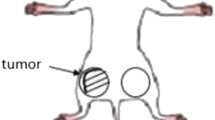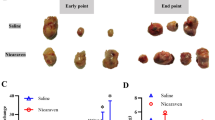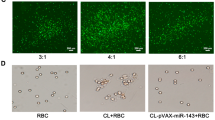Abstract
Purpose
The effect of multiple small dosages of the cytotoxic RNase, ranpirnase (ONCONASE®, ONC), on lung cancer was studied. The possible mechanisms for the enhanced tumoricidal efficacy of multiple small dosages of ONC were also investigated.
Methods
Hematoxylin and eosin staining, TUNEL labeling, and caspase-3-antibody labeling were used for in vivo analysis of apoptosis. A growth-delay assay was applied to detect the therapeutic potential of small and multiple dosages of ONC in vivo. ONC-induced changes in blood flow in A549 tumors and the kidney were measured non-invasively by dynamic contrast enhanced magnetic resonance imaging (DCE-MRI).
Results
In cell culture studies, ONC significantly inhibited tumor growth of A549 human NSCLC cells without damaging non-cancerous cells (HLF-1 human lung fibroblast). Multiple small dosages of ONC significantly prolonged tumor growth delay of A549 tumors, with increased apoptosis in vivo from 0.5 ± 0.3 to 70.1 ± 1.1% (by TUNEL labeling, N = 3, P < 0.05). Interestingly, multiple small doses of ONC were more effective than a single large dose for the inhibition of tumor growth with reduced side effect. Using non-invasive DCE-MRI methods, we found that the mean of the K trans median values increased to 49.3 ± 7.5% from the pre-ONC values by ONC (N = 4 mice, P < 0.05). A subsequent T 1 map of the kidney showed that T 1 values were temporarily decreased for up to 2 days (however, fully recovered ∼4 days post-treatment).
Conclusions
Multiple small dosages of ONC significantly inhibited tumor growth of A549 NSCLC cells in vivo, with markedly increased apoptosis. This investigation suggests important potential clinical uses of ONC for the treatment of NSCLC cancer patients.






Similar content being viewed by others
References
Ardelt W, Mikulski SM, Shogen K (1991) Amino acid sequence of an anti-tumor protein from Rana pipiens oocytes and early embryos: homology to pancreatic ribonucleases. J Biol Chem 266:245–251
Beani CP (2000) Combined modality therapy for unresectable stage III non-small cell lung cancer: new chemotherapy combinations. Chest 117:127s–132s
Costanzi J, Sidransky D, Navon A, Goldsweig H (2005) Ribonucleases as a novel pro-apoptonic anticancer strategy: review of the preclinical and clinical data for ranpirnase. Cancer Invest 3:643–650
Grabarek J, Ardelt B, Du L, Darzynkiewicz Z (2002) Activation of caspases and serine proteases during apoptosis induced by onconase (ranpirnase). Exp Cell 278:61–71
Iordanov MS, Ryabinina OP, Wong J, Dinh TH, Newton DL, Rybak SM, Magun BE (2000) Molecular determinants of apoptosis induced by the cytotoxic ribonuclease onconase: evidence for cytotoxic mechanisms different from inhibition of protein synthesis. Cancer Res 60:1983–1994
Jain RK (2005) Normalization of tumor vasculature: an emerging concept in antiangiogenic therapy. Science 307:58–62
Kim DH, Kim EJ, Kalota A, Gewirtz AM, Glickson J, Shogen K, Lee I (2007) Possible mechanisms of improved radiation response by cytotoxic RNase, ONCONASE®, on A549 human lung cancer xenografts of nude mice. Adv Exp Med Biol 599:53–59
Kong FM, Zhao L, Hayman JA (2006) The role of radiation therapy in thoracic tumors. Hematol Oncol Clin North Am 20:363–400
Leach MO, Brindle KM, Evelhoch JL, Griffths JR, Horsman MR, Jackson A, Jayson GC, Judson IR, Knopp MV, Maxwell RJ, McIntyre D, Proce P, Rathbone R, Rutin GJ, Tofts PS, Tozer GM, Vennart W, Waterson JC, Williams SR, Workman P (2005) The assessment of antiangiogenic and antivascular therapies in early-stage clinical trials using magnetic resonance imaging: issues and recommendations. Br J Cancer 92:1599–1610
Ledoux L (1955) Action of ribonuclease on certain ascites tumours. Nature 175:258–259
Ledoux L (1955) Action of ribonuclease on two solid tumours in vivo. Nature 176:35–37
Lee I, Boucher Y, Jain RK (1992) Nicotinamide can lower tumor interstitial fluid pressure: mechanistic and therapeutic implications. Cancer Res 52:3237–3240
Lee I, Lee YH, Mikulski SM, Lee J, Covone K, Shogen K (2000) Tumoricidal effects of onconase on various tumors. J Sur Oncol 73:164–171
Lee I, Lee YH, Mikulski SM, Lee J, Shogen K (2000) Enhanced cellular radiation sensitivity of androgen-independent human prostate tumor cells by onconase. Anticancer Res 20:1037–1040
Lee I, Kalota A, Gerwirtz AM, Shogen K (2007) Antitumor efficacy of the cytotoxic RNase, ranpirnase, on A549 human lung cancer xenografts of nude mice. Anticancer Res 27:299–308
Lee I, Kim DH, Sunar U, Magnitsky S, Yodh AG, Shogen K (2006) The physiological mechanisms of ranpirnase-induced enhancement in radiation response on A549 human lung carcinoma xenografts in nude mice. Int J Radiat Oncol Biol Phys 66:s580–s581
Mikulski SM, Costanzi JJ, Vogelzang NJ, McCachren S, Taub RN, Chun H, Mittelman A, Panella T, Puccio C, Fine R, Shogen K (2001) Phase II trial of a single weekly intravenous dose of ranpirnase in patients with unresectable malignant mesothelioma. J Clin Oncol 20:274–281
Penketh PG, Shyam K, Sartorelli AC (1996) Mechanisms of resistance to alkylating agents in drug resistance. In: Hait WN (ed) Drug resistance, Kluwer, Boston, pp 65–81
Rutkoski TJ, Kurten EL, Mitchell JC, Raines RT (2005) Disruption of shape-complementary markers to create cytotoxic variants of ribonuclease A. J Mol Biol 354:41–54
Rybak SM, Newton DL (1999) Natural and engineered cytotoxic ribonucleases: therapeutic potential. Exp Cell Res 253:325–335
Saxena SK, Sirdeshmukh R, Ardelts W, Mikulski SM, Shogen K, Youle RJ (2002) Entry into cells and selective degradation of tRNA by a cytotoxic member of the RNase A family. J Biol Chem 277:15142–15146
Sordella R, Bell DW, Harber DA, Settleman J (2004) Gefitinib-sensitizing EFGR mutations in lung cancer activate anti-apoptotic pathway. Science 305:1163–1167
Tracy S, Mukohara T, Hansen M, Meyerson M, Johnson BE, Jaenne PA (2004) Gefitinib induces apoptosis in EFGRL858R non-small-cell lung cancer line H3255. Cancer Res 64:7241–7244
Tofsts PS, Kermode AG (1991) Measurement of the blood–brain barrier permeability and leakage space using dynamic MR imaging. 1. Fundamental concepts. Magn Reson Med 17:357–367
Tofsts PS, Brix G, Buckley DL, Evelhoch JL, Henderson E, Knopp MV, Larsson HBW, Lee T, Mayr NA, Parker GJM, Port RE, Taylor J, Weisskoff RM (1999) Estimating kinetics parameters from dynamic contrast-enhanced T1-weighted MRI of a diffusible tracer: standardized quantities and symbols. J Magn Reson Imaging 10:223–232
Vasandani VM, Burris JA, Sung C (1999) Reversible nephrotoxicity of onconase and effect of lysine pH on renal onconase uptake. Cancer Chemother Pharmacol 44:164–169
Acknowledgments
This research was supported by Alfacell Corporation through their sponsorship research agreement with the University of Pennsylvania. The authors would like to express their thanks to Dr. Dae H. Kim’s assistance on the MRI studies. The authors also appreciate Daniel Martinez at the Pathology Core, Children’s Hospital of Philadelphia (CHOP), for his histological services for processing paraffin blocks and slides for the H & E staining, caspase-3 antibody labeling, and TUNEL staining studies.
Author information
Authors and Affiliations
Corresponding author
Rights and permissions
About this article
Cite this article
Lee, I., Shogen, K. Mechanisms of enhanced tumoricidal efficacy of multiple small dosages of ranpirnase, the novel cytotoxic ribonuclease, on lung cancer. Cancer Chemother Pharmacol 62, 337–346 (2008). https://doi.org/10.1007/s00280-007-0637-y
Received:
Accepted:
Published:
Issue Date:
DOI: https://doi.org/10.1007/s00280-007-0637-y




